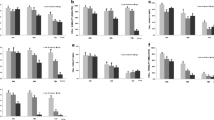Abstract
Several authors have demonstrated the chemoprotective and anti-carcinogenic role of selenium. However, the therapeutic potential of selenium in myelodysplastic syndrome (MDS) as single agent and as co-adjuvant of the current therapies has not been previously studied. Sodium selenite and selenomethionine, alone and in combination with cytarabine, induce a decrease in cell viability in a time-, dose- and administration-dependent manner inducing cell death by apoptosis in F36P cells (MDS cell line). These compounds increased superoxide production and induced mitochondrial membrane depolarization. The increase in BAX/BCL-2 ratio and in the activated caspase 3 expression levels, the decrease in mitochondria membrane potential, as well as the increase in superoxide production, supports the mitochondria contribution on selenium-induced apoptosis. These findings suggest that selenium may offer a new therapeutic approach in myelodysplastic syndrome in monotherapy and/or as co-adjuvant therapy to conventional anti-carcinogenic.





Similar content being viewed by others
References
Halliwell B (1999) Establishing the significance and optimal intake of dietary antioxidants: the biomarker concept. Nutr Rev 57:104–113
Kelloff GJ, Crowell JA, Steele VE, Lubet RA, Boone CW, Malone WA, Hawk ET, Lieberman R, Lawrence JA, Kopelovich L, Ali I, Viner JL, Sigman CC (1999) Progress in cancer chemoprevention. Ann N Y Acad Sci 889:1–13
Aggarwal BB, Shishodia S (2006) Molecular targets of dietary agents for prevention and therapy of cancer. Biochem Pharm 71:1397–1421
Martin KR (2006) Targeting apoptosis with dietary bioactive agents. Exp Biol Med 231:117–129
Ripoll EA, Rama BN, Webber MM (1986) Vitamin E enhances the chemotherapeutic effects of adriamycin on human prostatic carcinoma cells in vitro. J Urol 136(2):529–531
Kurbacher CM, Wagner U, Kolster B, Andreotti PE, Krebs D, Bruckner HW (1996) Ascorbic acid (vitamin C) improves the antineoplastic activity of doxorubicin, cisplatin and paclitaxel in human breast carcinoma cells in vitro. Cancer Lett 103(2):183–189
Woźniak G, Anuszewska EL (2002) Influence of vitamins C and E on cytotoxic activity of adriamycin in chosen cell cultures. Acta Pol Pharm 59(1):31–35
Prasad KN, Kumar B, Yan XD, Hanson AJ, Cole WC (2003) α-Tocopheryl succinate, the most effective form of vitamin e for adjuvant cancer treatment: a review. J Am Coll Nutr 22(2):108–117
Ip C (1998) Lessons from basic research in selenium and cancer prevention. J Nutr 128(11):1845–1854
Novotny L, Rauko P, Kombian SB, Edafiogho IO (2010) Selenium as a chemoprotective anti-cancer agent: reality or wishful thinking? Neoplasma 57(5):383–391
Zhong W, Oberley TD (2001) Redox-mediated effects of selenium on apoptosis and cell cycle in the LNCaP human prostate cancer cell line. Cancer Res 61(19):7071–7078
Zeng H (2002) Selenite and selenomethionine promote HL-60 cell cycle progression. J Nutr 132(4):674–679
Kim TS, Yun BY, Kim IY (2003) Induction of the mitochondrial permeability transition by selenium compounds mediated by oxidation of the protein thiol groups and generation of the superoxide. Biochem Pharmacol 66(12):2301–2311
Schrauzer GN (2008) Effects of selenium and low levels of lead on mammary tumor development and growth in MMTV-infected female mice. Biol Trace Elem Res 125(3):268–275
Drasch G, Schöpfer J, Schrauzer GN (2005) Selenium/cadmium ratios in human prostates: indicators of prostate cancer risk of smokers and nonsmokers, and relevance to the cancer protective effects of selenium. Biol Trace Elem Res 103(2):103–107
Hesketh J (2008) Nutrigenomics and selenium: gene expression patterns, physiological targets, and genetics. Annu Rev Nutr 28:157–177
Nimer SD (2008) Myelodysplastic syndromes. Blood 111(10):4841–4851
Farquhar MJ, Bowen DT (2003) Oxidative stress and the myelodysplastic syndromes. Int J Hematol 77(4):342–350
Young NS (2007) Aplastic anemia, myelodysplasia and related marrow failure syndromes. In: Fauci AS (ed) Harrison’s principles of internal medicine, 17th edn. McGraw-Hill, London, pp 663–671
Almeida S, Sarmento-Ribeiro AB, Januário C, Rego AC, Oliveira CR (2008) Evidence of apoptosis and mitochondrial abnormalities in peripheral blood cells of Huntington’s disease patients. Biochem Biophys Res Commun 374:599–603
Redman C, Scott JA, Baines AT, Basye JL, Clark LC, Calley C, Roe D, Payne CM, Nelson MA (1998) Inhibitory effect of selenomethionine on the growth of three selected human tumor cell lines. Cancer Lett 125(1–2):103–110
Freitas M, Alves V, Sarmento-Ribeiro AB, Mota-Pinto A (2011) Combined effect of sodium selenite and docetaxel on PC3 metastatic prostate cancer cell line. Biochem Biophys Res Commun 408:713–719
Guan L, Jiang Q, Li Z, Huang F, Ren Y, Yang Y, Xu C (2009) The subcellular distribution of MnSOD alters during sodium selenite-induced apoptosis. BMB Rep 42(6):361–366
Acknowledgments
Centro de Investigação em Meio Ambiente, Genética e Oncobiologia (CIMAGO) and Clinical Haematology Service, Centro Hospital e Universitário de Coimbra (HUC/CHUC) funded this study.
Conflict of Interest
The authors declare that they have no conflict of interests.
Author information
Authors and Affiliations
Corresponding author
Rights and permissions
About this article
Cite this article
Gonçalves, A.C., Barbosa-Ribeiro, A., Alves, V. et al. Selenium Compounds Induced ROS-Dependent Apoptosis in Myelodysplasia Cells. Biol Trace Elem Res 154, 440–447 (2013). https://doi.org/10.1007/s12011-013-9749-x
Received:
Accepted:
Published:
Issue Date:
DOI: https://doi.org/10.1007/s12011-013-9749-x



